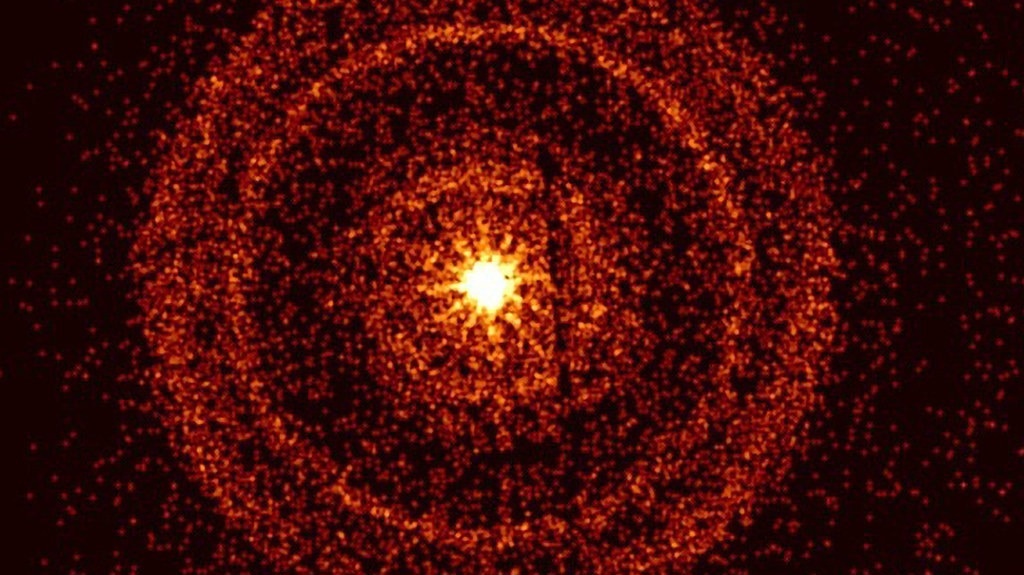The cosmic explosion observed on October 22nd, 2022 and fittingly dubbed the Brightest of All Time (BOAT) has garnered increased from space experts.
 The afterglow of the Brightest of All Time gamma-ray burst, captured by the Neil Gehrels Swift Observatory’s X-Ray Telescope. Image Credit: NASA/Swift/A. Beardmore (University of Leicester)
The afterglow of the Brightest of All Time gamma-ray burst, captured by the Neil Gehrels Swift Observatory’s X-Ray Telescope. Image Credit: NASA/Swift/A. Beardmore (University of Leicester)
An extremely intense flash of gamma rays and a slowly fading afterglow of light across frequencies were seen as a result of the formation of a black hole following the demise of a tremendously massive star.
Astrophysicists from all across the world have been frantically trying to explain the strength of the gamma-ray burst (GRB) and the oddly long fading of its afterglow ever since simultaneously picked up the BOAT signal on their massive telescopes.
The initial burst, known as GRB 221009A, was angled directly at Earth and left an unusually large amount of stellar material in its wake, according to a new theory developed by an international team that includes Dr. Hendrik Van Eerten from the Department of Physics at the University of Bath.
The team’s findings are now available in the esteemed journal Science Advances. The lead author of the study is Dr. Brendan O’Connor, a recently graduated Ph.D. student from the University of Maryland and George Washington University in Washington, DC.
Other researchers working on this puzzle have also come to the conclusion that the jet was pointed directly at us—much like a garden hose angled to spray straight at you—and this definitely goes some way to explain why it was seen so brightly.
Dr. Hendrik Van Eerten, Reader, Department of Physics, University of Bath
The fact that the margins of the jet could not be seen at all, however, remained a mystery.
Dr. Van Eerten added, “The slow fade of the afterglow is not characteristic of a narrow jet of gas, and knowing this made us suspect there was an additional reason for the intensity of the explosion, and our mathematical models have borne this out. Our work clearly shows that the GRB had a unique structure, with observations gradually revealing a narrow jet embedded within a wider gas outflow where an isolated jet would normally be expected.”
So, what caused this GRB to be wider than usual? The scientists have a hypothesis.
“GRB jets need to go through the collapsing star in which they are formed, and what we think made the difference in this case was the amount of mixing that happened between the stellar material and the jet, such that shock-heated gas kept appearing in our line of sight all the way up to the point that any characteristic jet signature would have been lost in the overall emission from the afterglow,” stated Dr. Van Eerten.
Our model helps not just to understand the BOAT, but also previous brightness record holders that had astronomers mystified about their lack of jet signature. These GRBs, like other GRBs, must be directed straight towards us when they happen, as it would be unphysical for that much energy to be expelled in all directions at once.
Dr. Hendrik Van Eerten, Reader, Department of Physics, University of Bath
He stated, “An exceptional class of events appears to exist that are both extreme and manage to mask the directed nature of their gas flow. Future study into the magnetic fields that launch the jet and into the massive stars that host them should help reveal why these GRBs are so rare.”
Dr Brendan O’Connor, study lead author, added, “The exceptionally long GRB 221009A is the brightest GRB ever recorded and its afterglow is smashing all records at all wavelengths. Because this burst is so bright and also nearby (cosmically speaking: it occurred at the minor distance of 2.4 billion light years from Earth), we think this is a once-in-a-thousand-year opportunity to address some of the most fundamental questions regarding these explosions, from the formation of black holes to tests of dark matter models.”
Journal Reference:
O’Connor, B., et al. (2023) A structured jet explains the extreme GRB 221009A. Science Advances. doi:10.1126/sciadv.adi1405